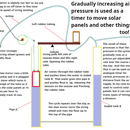Introduction: Build a Fermentation Fueled Water Pump
The pump will work using the pressure built up by the gas released from any fermentation process. I expect that yeast and lactic acid fermentation will work well. The "fuel" can be kitchen waste or garden waste.
I think these pumps will be used to slowly recirculate water and compost tea to plants in pots and to soil blocks and various stuff like that. Plant spirals could be built with a water reservoir at the bottom and this pump could keep a steady slow stream of water going. It might also be used in the windowfarm project. I see that it might have potentials for keeping compost heaps moist too.
I have uploaded a video of the same thing powered by an aquarium air pump.
http://www.youtube.com/watch?v=G6pfE_IxVgQ I think it is worth a look because you can clearly see the pump and refill cycles in that video. These cycles take much longer when it is biofueled (especially in winter).
Brrr, cold and yucky in my little shed!
Step 1: The Digester
This is the container that produces the bubbles. I used a 2 liter pop bottle and yeast and sugar for the first one. It worked. Next I decided to use kitchen waste in a large water container. It is about 5 gallon in size and it has a fairly big "mouth" I had to buy an oversize cork for it.
Step 2: The Pump Pacemaker
This part is an energy drink bottle (because it has a wide mouth) The bung for the bottle has 3 holes. One for filling water into it. One for gas entry from the digester. And one to pump the water out.
It contains a siphon tube into a larger tube that also contains the outlet pipe.
Step 3: Overview of the Pump
This picture shows the pump in action
Step 4: Uses for the Pump.
The pump could be used to power or provide circulating water for
A window farm,
A moss garden.
A "gentle drip" water feature
Wall gardens
Plants in pots
soil blocks
herb or vegetable spiral
or compost bin.
Step 5: Equipment List and Explanation.
I used a set of bung borers for making the holes in the bungs. (I have had that set for about 20 years) It is just a set of thin walled hollow metal pipes that you rotate down through the soft rubber of the bungs to cut a hole.
The rubber bungs were bought at a local wine and beer equipment supplier. You probably need to bring your measuring tape or ruler and pick out the right bungs for your energy drinks container, empty pop bottle or 5 gallon bulk water container
Tubing was obtained at a garage sale and at local hardware stores. 3 mm and 6 mm tubing should work for most of it. The wide tubing for the outer part of the siphon tube was also bought in a hardware store. You just have to bring in your energy drink bottle to see what fits inside. (Remember that you need to get the skinny siphon tube to fit in outside the wide tube of the siphon).
I cut the hole through the wide tube with the bung borer.
I used a tile drill to drill through the glass jar. (I do not recommend doing that) Too much overheating and cracking danger.
Step 6: Try to Make One.
I have never seen this type of pump on the internet or elsewhere. It is a pretty simple build so perhaps someone could replicate it. It always takes one brave person to dip their toe in the water.
Some people say this pump is a "hero's fountain".
(Kind of funny because one of my nicknames playing soccer in school was "the hero")
However, I do not think Hero of Alexandria added fermentation power to his fountains.
(Maybe he did) and I do not think he had a little siphon in it either. I think his pumps stayed going for a few hours max. This little thing can stay going for as long as the fermentation goes so i guess up to 3 weeks between recharging the digester. But it does have an automatic fill empty cycle so it is not constantly pumping water up.
Anyway, check it out and give it a try please. It just might turn out to be really useful to some people.
Brian
Step 7: The Future Development of This Pump?
I hope this allows people to see "bio-fuel" in a different light.
If you want to recirculate water or compost tea around plants, this is a new option.
It may or may not be efficient enough to recirculate for hydroponics but even if it isn't it can still be used with seedlings to keep them moist.
I think that if you need a flood of water, you can have one of the Chineese bamboo thingys up top and when it fills enough, it tips out the water. (This might be the way to go with soil blocks too so they get enough water without getting waterlogged)
This is an anaerobic process so there is lots of energy left in the material after the fermentation. (Fermentation products like alcohol, acetic acid, lactic acid, silage and sauerkraut are all still full of energy) As the fermentation "winds down" there might be a way to add air to the digester on the "empty" cycle to keep the thing bubbling. (But I do not know if the O2 to CO2 conversion generates any excess gas). Looking at that part, it clearly doesn't!) But there are probably many reactions going on under aerobic conditions so maybe there is excess gas from those reactions?













